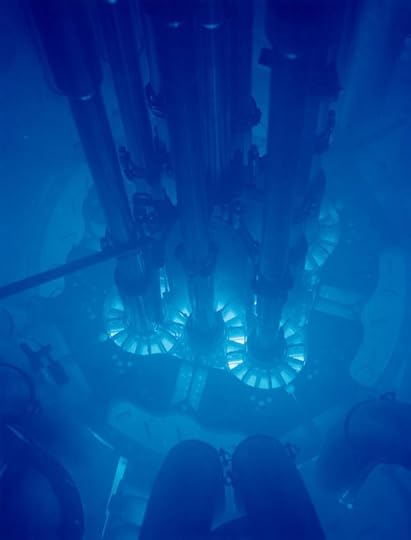What would you see if you travelled faster than light?
In one of the comments in response to Ann Nyland’s excellent article on time travel, Earl Rogers asks what you would see if you were Captain Kirk on the starship Enterprise streaking away from the Earth at faster than the speed of light. Would you see time running backward?
What a great question. To which the answer is: I don’t know. So I’m hoping someone will read this post and answer that question.
And it is a great question, isn’t it? We’re used to special effects in TV and film, where the stars blur into lines when the Star Trek warp engines engage, or the swirly-whirly weirdness when you look out of the window while in hyperspace. But how much of this is real? I know there are science fiction writers who read this blog. Perhaps we’ll learn something to add a little verisimilitude to our fiction. (Verisimilitude is a word I would never have come across if I didn’t read science fiction; it means realism.)
I’ll set out the little that I know and at the end I’ll show a photograph of genuine faster-than-light travel (yes, really).
Relativistic Doppler Effect
Let’s start with sub-light speeds where we approach but don’t exceed the speed of light. A couple of effects come into play here. One is the Doppler Effect, which you will recognize when applied to sound. It’s the change in wavelength when something approaches you and then passes you, the sound of the siren from a racing ambulance lowers in pitch as it passes.
The same thing happens with light, although you also get an effect that I don’t fully understand called aberration, which narrows the light reaching you as you face forward in the direction of travel.
So on your near-c spacecraft (or if you’re a caped superhero capable of such speeds) if you look ahead, you see the Universe blueshift (Doppler Effect makes the light appear blue) and also narrow into an ever-shrinking cone of light. Eventually the light blueshifts into the ultraviolet and shrinks to a point.

Relativistic effects. If this doesn’t animate, try clicking it.
If you look behind you (which was Earl’s original question) then the light does the opposite. It smears out and redshifts until it passes out of the visible light spectrum and into infrared.
That’s a dramatic effect, but look behind at the Earth and it’s the same old Earth moving forward in time, just seen through distorted light. Although I’m sure if you’ve built your spaceship or enhanced your body to travel at such speeds, you can adjust the light to bring it back into the visible spectrum and sharpen the image.
Superluminal travel
Superluminal travel is going faster than the speed of light (I had to get superluminal in this post because it’s one of my son’s favorite words, the others being cake and Lego). What do you see when you’re superluminal?
This is where I’m looking for some help…

An object approaching at faster than light. If this doesn’t animate, try clicking. Source: Wikipedia
According to Wikipedia, when a superluminal object travels towards you, it is invisible until it passes you and you are hit by a luminal boom (like a sonic boom). Then you see a redshifted image of the object passing away and beyond you. At the same time you also see (if you have eyes in the back of your head) a blueshifted image of the object approaching you. Here’s the interesting bit… if I’ve understood this correctly, the light hitting you from the approaching object arrives in the wrong order; the object appears to move backwards. In other words, suppose you’re on an asteroid in your spacesuit and the Starship Enterprise passes you at warp factor 3. Here’s what I think you see:
BOOM! The luminal boom hits. Lots of Cerenkov Radiation (which I’ll come to in a moment) which I’m guessing will look like a burst of blue ball lightning (that’s mostly a guess, folks)
Then the Enterprise screams past (metaphorically; there’s no sound in a vacuum) in both directions simultaneously!
In one direction, the Enterprise is redshifted. This is the true direction of travel.
In the other direction, the Enterprise is blueshifted. The ship appears to be moving backwards, away from you, but that’s a trick of the light. Because the Enterprise is moving faster than light, it’s overtaking the light coming off it. So you see the light from the Enterprise when it’s 1 mile away from you before you see the light from when it was 100 miles away — thus it appears to move backwards.
How much is the light blue- and red-shifted? I’ve no idea. I suppose it depends on the speed of travel. Perhaps at warp factor 3 the observer sees an interesting visual effect (an opportunity there for space-tourism?). But there again at warp factor 10, maybe the Doppler Effect is so extreme that it kills you: the blueshifted light shifts out of the visible spectrum, past ultraviolet to bathe you in lethal X-rays. Meanwhile the redshifted light goes beyond infrared into microwaves, which instantly turn your corneas into giant cataracts (apparently your corneas would fry first because there are no blood vessels to take the heat away) and shortly after you would boil (in which case this could be an opportunity for space-catering — leave dishes underneath a flight path of superluminal ships and have your food cooked for free).
By the way, I have looked into this topic before. I Every time I look, there seems to be more detail and better diagrams on Wikipedia. I like Wikipedia!
Do you see time running backwards?
We still haven’t directly answered the original question. If you travel faster than light and look back at the Earth, does time run backwards until you see dinosaurs?
Well, yes, I think you do, assuming you have telescopes powerful enough to see behind over great distances. Light from the time of the dinosaurs is still out there, scattered, diffuse, distorted, but still expanding through space at the speed of light. If you traveled fast enough you could overtake that light so you could observe it. And once you overtake the speed of light you would be seeing events in reverse order. So yes, if you want to see the dinosaurs for real, all you have to do is invent a faster-than-light spacecraft, and the capability to process the incredibly diffuse light from millions of years ago, and you could see the dinosaurs stalking the Earth… backwards!
The pedant in me insists that there is an easier way to see dinosaurs. It’s the old birds-are-really-dinosaurs idea. I hadn’t realized, until I helped my son with his homework recently, that biologists now classify birds as part of the Dinosauria clade (a clade is a branch on the tree of life, a grouping of species used in biological classification).

It’s official! Dinosaurs are still alive!
Faster than light travel on Earth

Ahmadinejad at the nuclear reactor
It is possible to see faster than light travel in real life. In fact, I did just that a few months ago; I saw it on the telly. I saw a news bulletin about the Iranians defiantly showing off their nuclear reactor. I think a reactor was being ceremoniously opened by President Ahmadinejad. Here’s a photo of him at the event. He’s in front of what looks like a deep swimming pool, or perhaps an enormous ice-cream-making machine. The water is blue and that blue is Cerenkov Radiation, an effect that happens when particles travel faster than light.
When we’ve been talking about faster than lightspeed, what we really mean is faster than the speed of light in a vacuum. Light travels much slower in water (about 0.75c), slow enough that radiation from the nuclear reactor is travelling through the water faster than the light is traveling through water. So, yes, you really are seeing a photograph where something is traveling faster than light.

An American nuclear reactor showing Cerenkov Radiation. Source: Wikipedia
Am I Right?
I’ve scooped some half-understood facts from Wikipedia and added my own flaky interpretation and filled some gaps. It sounds plausible enough for an episode of Doctor Who. But what would science fiction writers who know their science make of it, writers such as Gregory Benford, Stephen Baxter, and David Brin? Would anyone care to correct my inevitable mistakes?











